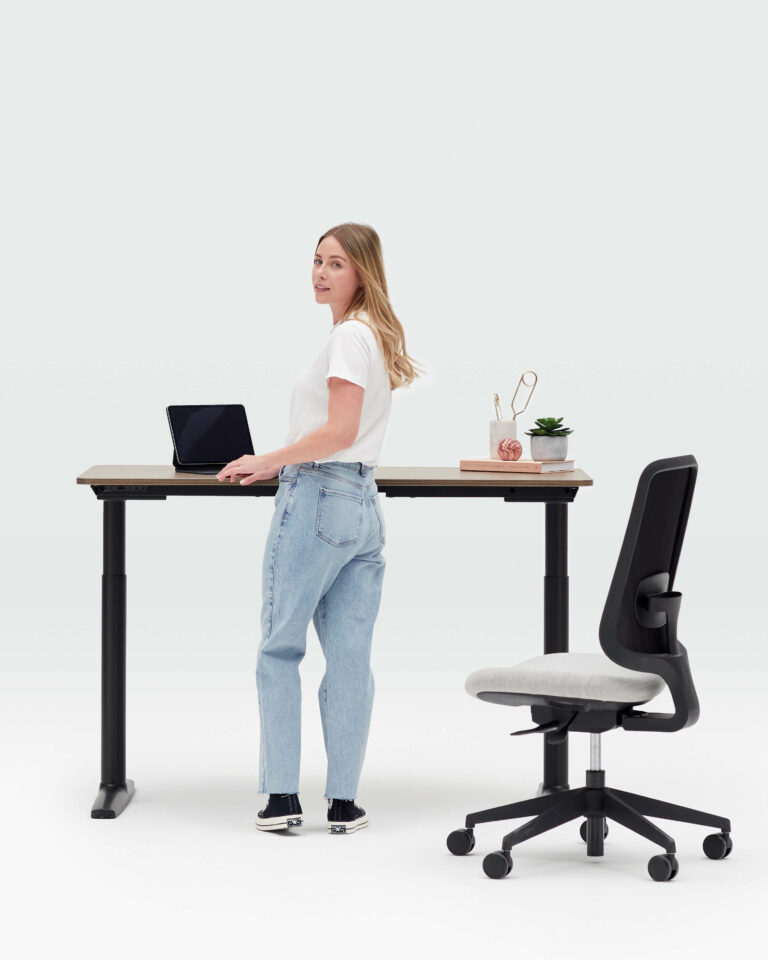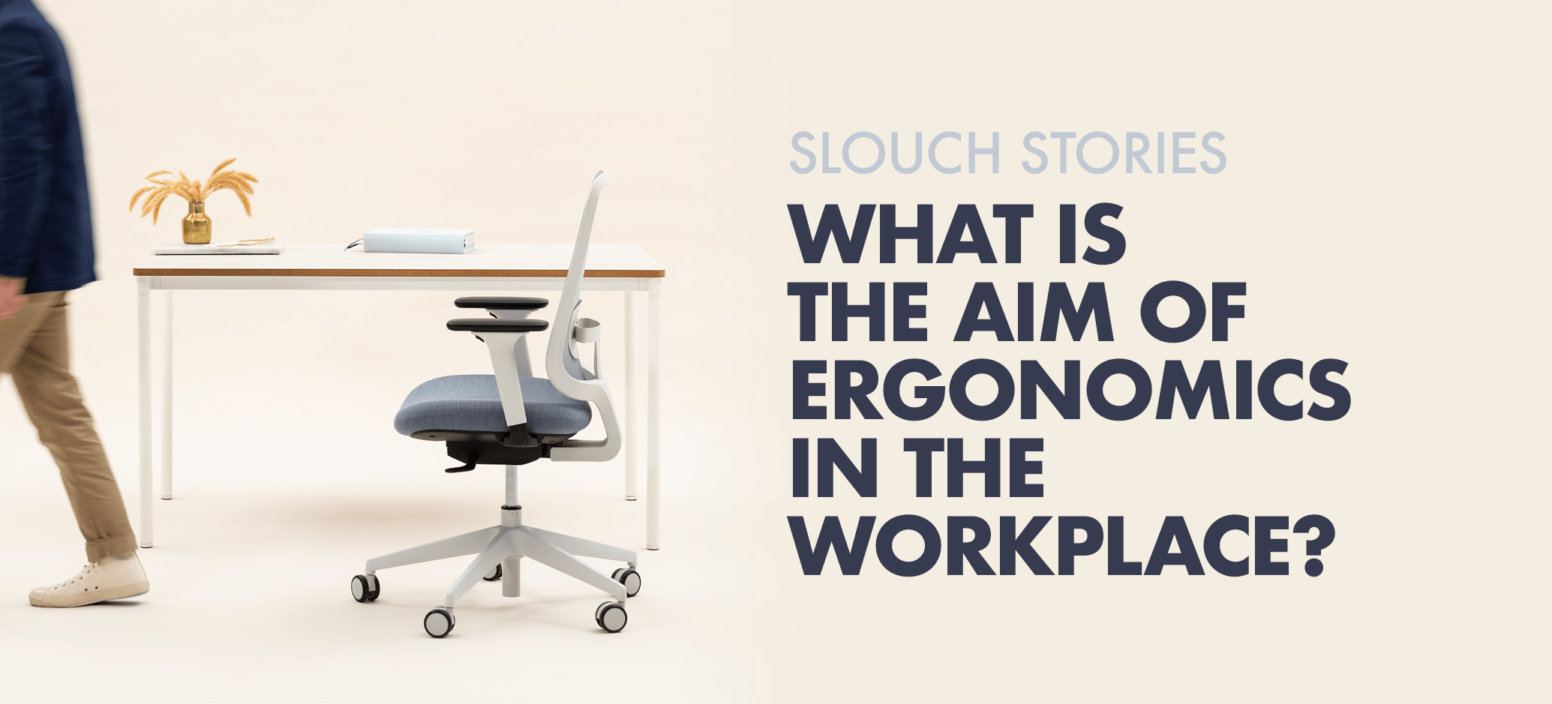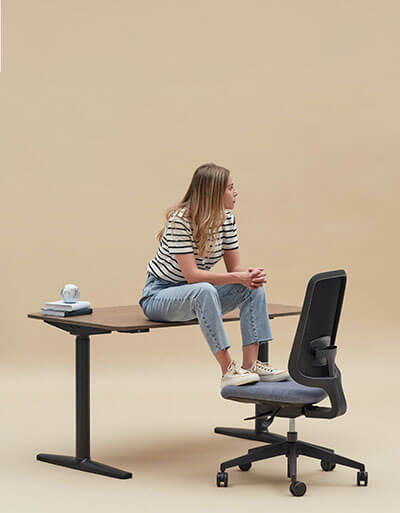What is the aim of ergonomics? To put it simply, ergonomics is about how easy it is for you as a worker to work. Does your workspace facilitate your work? Or does your workspace work against you?
Ergonomics in the workplace removes roadblocks and supports you in the ways you need to get the job done. It puts things within reach and makes things easier, more pleasant, and more comfortable.
When people think of the term ergonomics, it might make you think of sleek, beautifully designed office chairs that provide lumbar support and bragging rights that your home office is better than your mates. And while you wouldn’t be incorrect, the reality of ergonomics extends much further.
So let’s get to know ergonomics a bit better, and understand how it benefits you as a work-from-home-er. Ergonomic principles are at the forefront of what we do at Slouch after all.
WHAT IS THE AIM OF ERGONOMICS?
The aim of ergonomics is to guarantee that the working environment is in sync with the worker’s actions. In doing so, ergonomics can achieve a host of benefits:
1. IMPROVED HEALTH AND WELLBEING
As discussed in our blog about lumbar support, office chairs which provide cushioning and support for the curve in the spine can improve posture and mitigate musculoskeletal strain. But aside from this small example, ergonomics isn’t only about how well-designed office chairs can benefit your health.
How about office desks which are adjustable to prevent back pain, neck strain or repetitive strain injuries from stooping, hunching or over-extending? Or monitors which can adjust height or tilt? Keyboards with risers to avoid wrist strain and carpal tunnel?
A Display Screen Equipment (DSE) assessment is done in office environments in order to reduce the number of risks involved with using screens and workstations, ensuring health and well-being isn’t negatively impacted at the workplace. It’s also an opportunity to identify if there are any ergonomic improvements which could be made to minimise hazards related and reduce awkward movements or uncomfortable working conditions.
2. HIGHER PRODUCTIVITY AND EFFICIENCY
The workstation becomes more productive when it is designed to allow for optimal working posture, less exertion, fewer motions, better heights and making sure what you need is within reach.
As ergonomics takes into account the workflow and the placement of tools, it strives to reduce the time and effort needed to perform daily tasks. It also means employees can sustain their energy levels throughout the day, leading to consistent performance and higher productivity.
Ergonomically designed work environments contribute to improved mental well-being, as stress, discomfort and distraction can all negatively impact workflow and comfortable, supported users are more inclined to stay on task.
3. IMPROVED JOB SATISFACTION

Ergonomics can reduce stress and anxiety by providing employees with a sense of control over their work environment, allowing employees to personalise their workspace and fostering a sense of ownership and control.
It also recognises and accommodates diversity in the workforce, taking into account individual differences in body size, shape, and preferences. Employees are more likely to stay with a company that invests in their comfort and health and treats them as individuals, leading to greater retention.
4. A WORKSPACE WHICH ADAPTS IS A WORKSPACE WHICH IS INCLUSIVE
If elements of a workspace like chairs, office desks, monitors and keyboards can adapt to the user, this creates a work environment which can accommodate height, weight or ability and welcomes all kinds of people instead of excluding them. This makes it easier for individuals with specific needs or disabilities to navigate, interact with and be productive at their workstations
Accommodating different needs makes for a happier workforce, and in the event you’re purchasing this furniture for a home office, adaptability means the products can serve multiple purposes for the whole family. And if there’s something we love, it’s getting our money’s worth.
HOW BAD DESIGN CAN IMPACT YOUR LIFE
The impact of poor ergonomic design can have far-reaching consequences. Desks, chairs and monitors which don’t shift, rise or tilt could ostracise people of different sizes or abilities at the risk of them ‘making do’ and suffering in the long term.
Products, workstations, or environments that aren’t designed with YOU at the forefront of decision-making can lead to detrimental effects on human health and well-being, like discomfort, pain, and musculoskeletal disorders brought about by lack of support, repetitive movements or improper posture.
Common health consequences of products designed without considering the aim of ergonomics include:
- Recurrent headaches
- Eye strain
- Neck Strain
- Upper Limb Disorders affecting the arms and neck
- Lower Back Pain
- Tender Muscles
- Carpal Tunnel
- Herniated Disc
So bear these negatives in mind the next time you’re sitting in an unaccommodating office chair.
HIGH-PERFORMANCE OFFICE FURNITURE WITH YOUR WELLBEING AT ITS CORE AT SLOUCH
At Slouch we’re sticklers for getting top-tier performance out of our designs for the above reasons. When it comes to your comfort in your workplace and your work-from-home space, we want you to keep in mind the consequences of products and furniture that’s poorly designed without you in mind.
So when asking what is the aim of ergonomics – it’s not just about whether home office furniture is modern or stylish or backed by engineering.
It’s what you stand to lose if you purchase any old office furniture at a low price.
And it’s what you could stand to gain if you set your sights on products with your comfort and satisfaction at the core of its design.
If you have any enquiries, you can reach us at [email protected] and our experts will be in touch to assist. Otherwise, why not invest in yourself with Slouch home office furniture today and fill out this contact form today.

